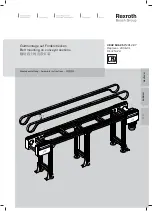
PB-LB1-13-10-10 - 1005-102/03
LEKTROMIK
B1
KIMO
- 13 -
Prüfungen vor dem ersten Einschalten:
First-time check of electrical system:
Vor dem erstmaligen Einschalten der Spannungsversorgung
ist folgendes zu überprüfen:
1. Die Spannungsversorgung ist ordnungsgemäß vorhan-
den und richtig angeschlossen.
2. Die Motor-Nennspannung entspricht der Spannungsver-
sorgung und der Motor ist korrekt im Stern oder Dreieck
verschaltet und an das LEKTROMIK B1 Bremsmodul
angeschlossen.
3. Die externe Verdrahtung wie Leistungsanschlüsse,
Steueranschlüsse, Motoranschlüsse und insbesondere
der Schutzleiteranschluss ist sachgerecht ausgeführt.
HINWEIS:
Vor einer Hochspannungs-Isolationsprüfung des
Motors oder der Verdrahtung (z.B. mit einem
Kurbelinduktor) ist das LEKTROMIK B1 Brems-
modul unbedingt vom zu überprüfenden Teil zu
trennen.
4. Sichtbare Beschädigungen am LEKTROMIK B1 Brems-
modul oder an der Verdrahtung sind nicht feststellbar.
5. Keine Fremdkörper (z.B. Bohrspäne, lose Drahtenden)
befinden sich im bzw. am LEKTROMIK B1 Bremsmodul
oder angeschlossenen Betriebsmitteln.
6. Motorwelle und, soweit vorhanden, Fremdlüfter lassen
sich leicht von Hand drehen.
Before power is applied to the system the following items
should be checked:
1. Voltage supply is correct and within the specification.
2. Motor is of correct voltage rating and is connected to the
LEKTROMIK B1 brake module in either star or delta
as is appropriate.
3. All external wiring circuits such as power connections,
control connections, motor connections and in particular
protective earth connections have been wired correctly.
NOTE:
Completely disconnect the LEKTROMIK B1
brake module before point-to-point checking
with a buzzer or when checking insulation with
a megger.
4. Check for visual damage to LEKTROMIK B1 brake
module or associated equipment.
5. Check for loose ends, clippings, drilling chips, etc.,
lodged in the LEKTROMIK B1 brake module or ancillary
equipment.
6. If possible check that the motor can be turned freely and
that the cooling fan is intact and free of obstructions.
Sicherheit des Antriebssystems:
Safety considerations:
Die Sicherheit des kompletten Antriebssystems ist zu überprü-
fen. Insbesondere ist sicherzustellen, dass
1. ein Antrieb der Maschine in beiden Richtungen nicht zu
Schäden führen kann,
2. niemand an der Maschine oder der Steuerung arbeitet
der durch das Zuschalten der Spannungsversorgung
oder Bewegen des Antriebs gefährdet werden kann,
3. ein Beschädigen anderer Einrichtungen oder Teile durch
das Zuschalten der Spannungsversorgung oder
Bewegen des Antriebs ausgeschlossen ist.
Ensure the safety of the complete system when the drive is
energized. In particular ensure:
1. That rotation of the motor in either direction will not
cause damage.
2. That nobody else is working on another part of the
equipment which will be affected by powering up or drive
movements.
3. That other equipment will not be adversely affected by
applying the supply voltage or by drive movements.
Schrittweise Inbetriebnahme
Step-by-step putting into operation
1. Voreinstellungen:
Die Einstellpotentiometer B und A sind mittig (3 Uhr) ein-
zustellen.
2. Einstellung der Bremswirkung:
Mit Potentiometer (B) gewünschtes Bremsmoment justie-
ren. Drehen im Uhrzeigersinn erhöht das Bremsmoment.
3. Einstellung der Bremsabschaltzeit:
Mit Potentiometer (A) Bremszeit justieren. Drehen im
Uhrzeigersinn verkürzt die Bremszeit. Nach Ablauf dieser
Zeit und einer Verzögerung von 1,5 s öffnet ein Kontakt
zwischen den Klemmen 1 und 2. Dieser Kontakt dient
zum Öffnen des Hauptschützes am Ende des Brems-
vorganges. Die Bremszeit ist so einzustellen, dass das
Hauptschütz kurz nachdem der Motor steht, abfällt.
4. Verwenden Sie eine Strommesszange mit Effektivwert-
Ermittlung, um sicher zu stellen, dass die maximalen
Bremsströme in Abhängigkeit des ED nicht überschritten
werden. Der Strom ist im Anschluss U1 zu messen.
1. Initial settings:
Set both potentiometers B and A to mid range
(3 o'clock).
2. Adjustment of d.c. injection brake operation:
Adjust required braking torque with potentiometer (B).
Clockwise rotation increases the braking torque.
3. Adjustment of braking time-out:
Adjust braking time with potentiometer (A). Clockwise
rotation shortens the braking time-out. At the end of the
set time and a delay of 1.5 sec the contact between
terminals 1 and 2 opens. This contact is provided to trip
the braking contactor at the end of braking operation.
Adjust the braking time-out such that the braking
contactor trips shortly after the motor comes to a halt.
4. Use a clip-on current probe with true rms indication to
verify that the maximum braking currents are not
exceeded. Measure the current in terminal U1.










































